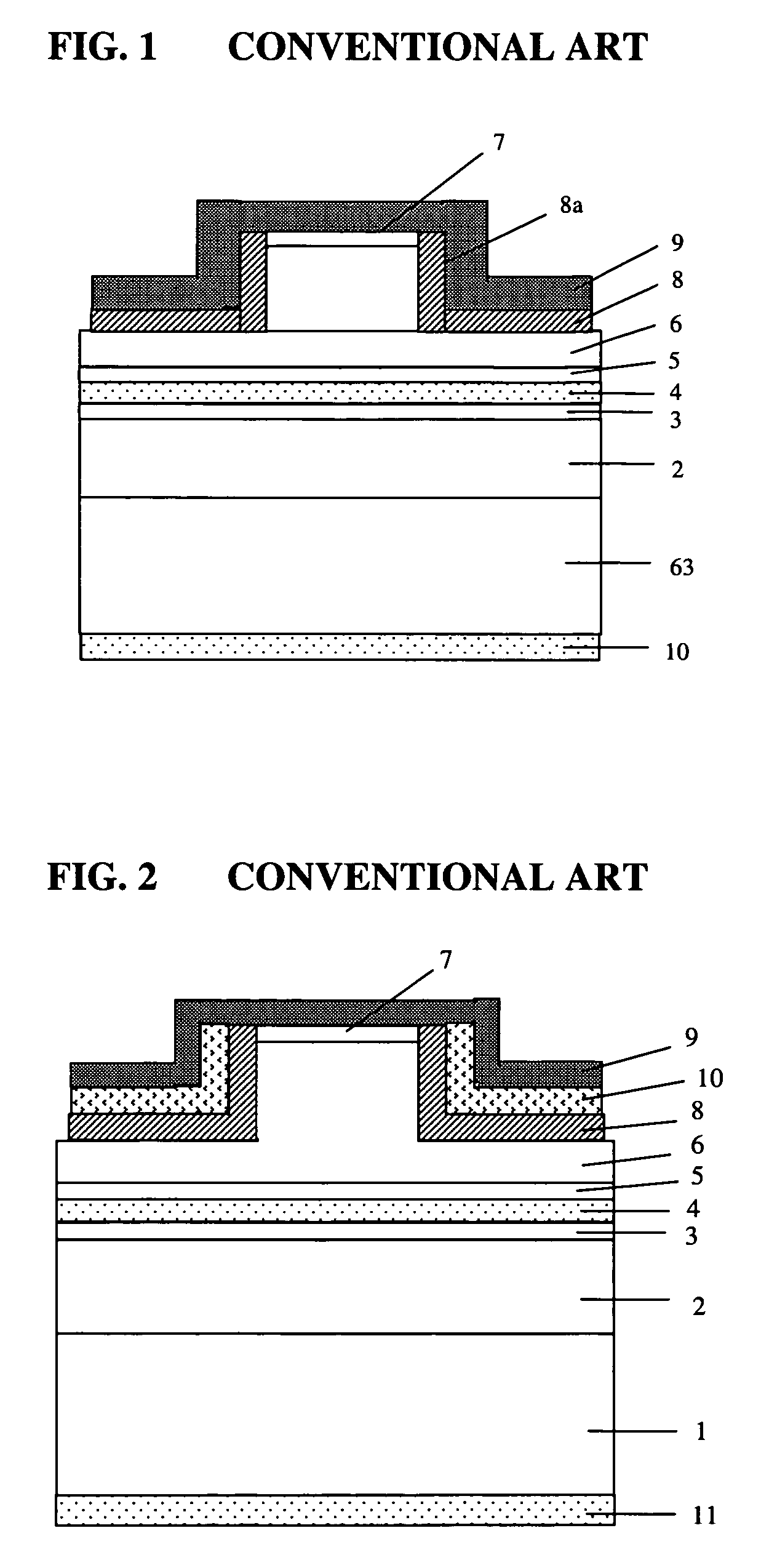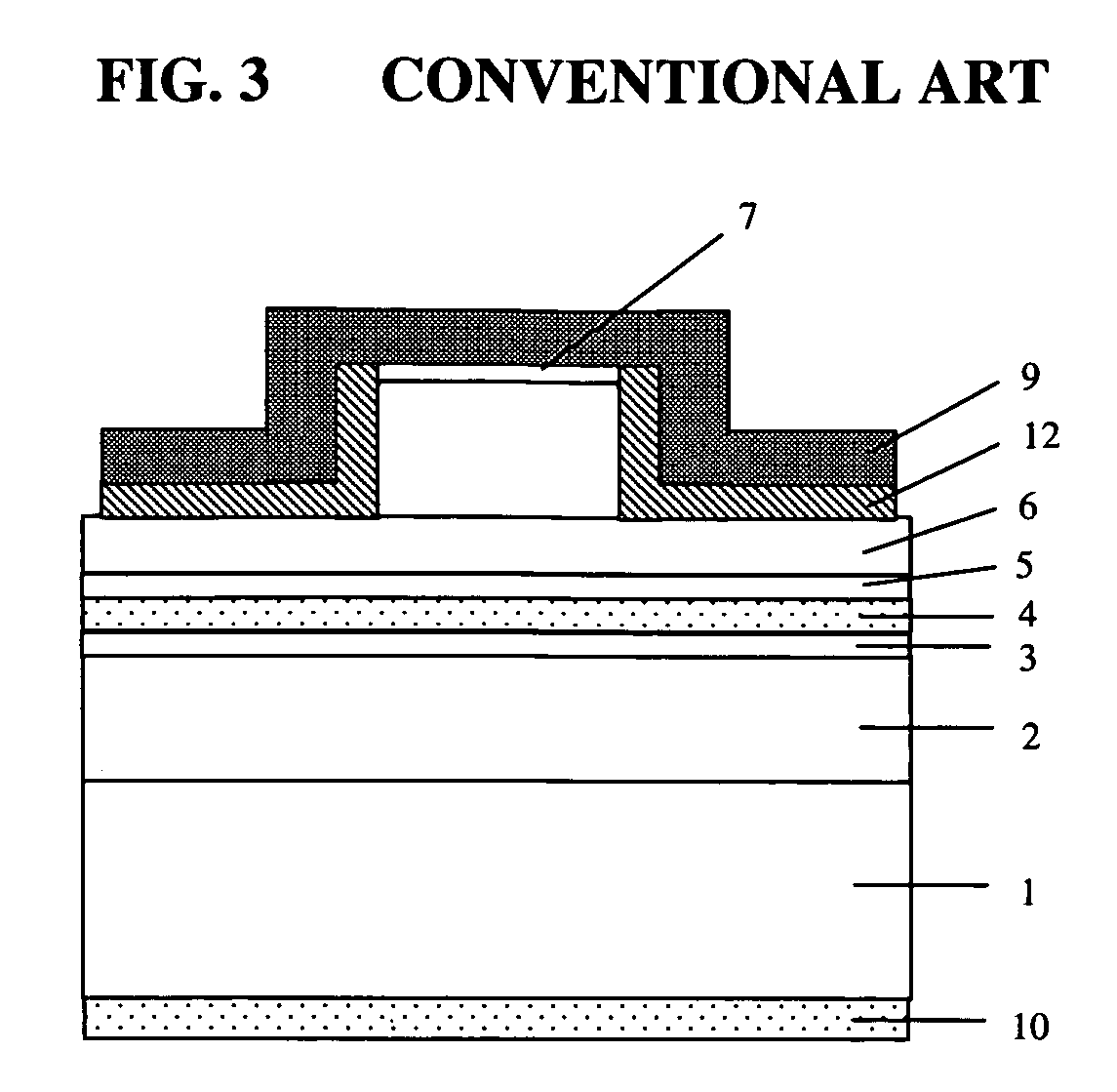Laser diode with improved heat dissipation
a laser diode and heat dissipation technology, applied in the field of semiconductor laser diodes, can solve the problems of reducing the slope efficiency and maximum power output, increasing the threshold current, and reducing the efficiency of ld devices, so as to improve the heat dissipation properties and good optical confinement
- Summary
- Abstract
- Description
- Claims
- Application Information
AI Technical Summary
Benefits of technology
Problems solved by technology
Method used
Image
Examples
embodiment 1
i) EMBODIMENT 1
[0044]A first embodiment of a laser diode structure in accordance with the present invention is illustrated in FIG. 4A. Referring to FIG. 4A, the laser diode structure includes a substrate 50 (such as n-type GaN substrate), followed by an n-type lower cladding layer 51, an n-type lower waveguide layer 52, an active layer 53, a p-type upper waveguide layer 54, a p-type upper cladding layer 55, and a p-type contact layer 56. The cladding layers are formed by material having a lower refractive index than the waveguide layers, and the waveguide layers have a lower refractive index than the active layer. The active layer 53 may consist of a single or multiple-quantum well structure. It is preferable that a thin AlxGa1-xN blocking layer is inserted at one or both ends of the active layer to reduce carrier leakage into the waveguide layers. Electrical contact is made via the p-type electrode layer 57 and the n-type electrode layer 59. A low refractive index insulator (i.e., ...
embodiment 2
ii) EMBODIMENT 2
[0049]According to this embodiment, the structure in FIG. 4A can be modified and improved to the structure shown in FIG. 5B. FIG. 5A shows the overlap of the optical mode with the low refractive index SiO2 insulator 61a occurs mainly at the bottom of the ridge. Therefore, good optical mode confinement can still be achieved by having the SiO2 layer only at the bottom region of the ridge sidewalls 61b. A high thermal conductivity insulator (i.e. AlN) can then replace the SiO2 layer at the top region of the ridge sidewalls 63a, thus allowing better heat dissipation through the top of the ridge, as shown in FIG. 5B. In FIG. 5C, the simulated L-I characteristics and active region temperature is shown for the conventional SiO2-only structure (FIG. 1) and the invention structure, as a function of different SiO2 thickness at the ridge sidewalls. In the simulation, the mesa height of the ridge sidewall is fixed at 500 nm, hence 500 nm-SiO2 refers to the insulator thickness co...
embodiment 3
iii) EMBODIMENT 3
[0050]According to this embodiment, a reverse structure is also proposed, and is shown in FIG. 6A. For this structure, the high thermal conductivity insulator layer 63 is formed at the ridge sidewalls while the low refractive index insulator layer 61 is formed at the etched surfaces. FIG. 6B and FIG. 6C show the simulated active region temperature profile in Kelvin for the reverse structure of the invention (FIG. 6C) and the conventional single layer insulator structure (FIG. 6B). FIG. 6D compares the L-I characteristics and active region temperature profile for the original invention structure, the reverse invention structure and the conventional single layer SiO2 structure. From the graphs, the reverse invention structure has a reduced active region temperature profile over the conventional structure, but is still poorer than the original invention structure. Observe that the L-I curve for the original invention structure (embodiment 1) has a much reduced thermal ...
PUM
 Login to View More
Login to View More Abstract
Description
Claims
Application Information
 Login to View More
Login to View More - R&D
- Intellectual Property
- Life Sciences
- Materials
- Tech Scout
- Unparalleled Data Quality
- Higher Quality Content
- 60% Fewer Hallucinations
Browse by: Latest US Patents, China's latest patents, Technical Efficacy Thesaurus, Application Domain, Technology Topic, Popular Technical Reports.
© 2025 PatSnap. All rights reserved.Legal|Privacy policy|Modern Slavery Act Transparency Statement|Sitemap|About US| Contact US: help@patsnap.com



